¶ Key Understanding:
- Multi-cellular organisms (such as plants) require the need of a transport system.
- In plants, water and nutrients are transported in vascular bundles.
- Transpiration results in water being drawn into a plant through the roots and water being lost through the leaves.
- The rate of transpiration is affected by environmental factors.
- Plants have various adaptations to reduce the rate of transpiration.
¶ Summary Overview
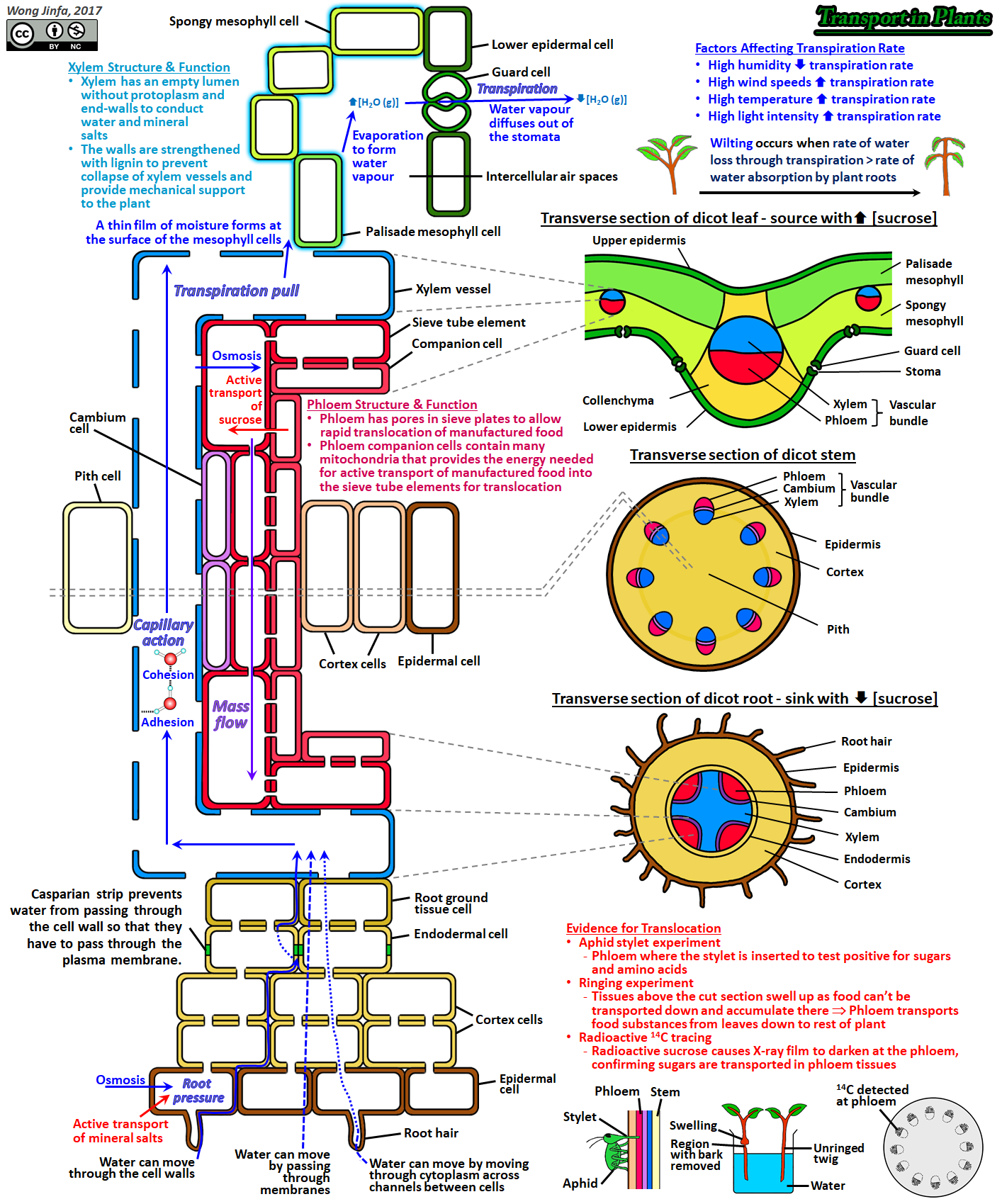
Click on the image below to go to an animation that shows how transport, respiration, photosynthesis and growth occurs in a plant by Science & Plant For Schools
[http://www.saps.org.uk/images/animation_all.jpg https://camtools.cam.ac.uk/access/content/group/5234dd8c-893c-44c2-ba59-69f09f2f02ab/Public/Animation-4/index.html]
¶ Lesson Objectives:
¶ Describe the distribution of tissues in sections of a herbaceous dicotyledonous leaf, stem and root and identify these structures, as seen in transverse section, using with the light microscope.
¶ Root
- The outermost layer of cells in the root is called the epidermis
- Root hairs are tubular outgrowths of the epidermal cells
- They are long and narrow to increase surface area to volume ratio for higher water absorption
- The selectively permeable cell surface membrane prevents cell sap from leaking out, resulting in a concentrated cell sap, thus maintaining a lower water potential than the water in the soil, allowing osmosis to take place
- The root hair cells contain many mitochondria to produce energy for active transport of mineral salts into the cell
- The cortex of the root is the layer between the stele (containing the vascular tissues) and the epidermis
- This layer contains the ground tissue that supports the other plant cells and stores starch granules
- The innermost layer of the cortex is made up of endodermis cells that have a layer of suberin (called the Casparian strip) that prevents water from moving through the cell walls
- The stele, containing the vascular tissues, form the innermost layer of the root
- The xylem tissues, which span out from the center of the root, alternate with phloem tissue between its arms
- The xylem tissues are responsible for transporting water up the plant
- The phloem tissues are responsible for transporting dissolved nutrients in the plant
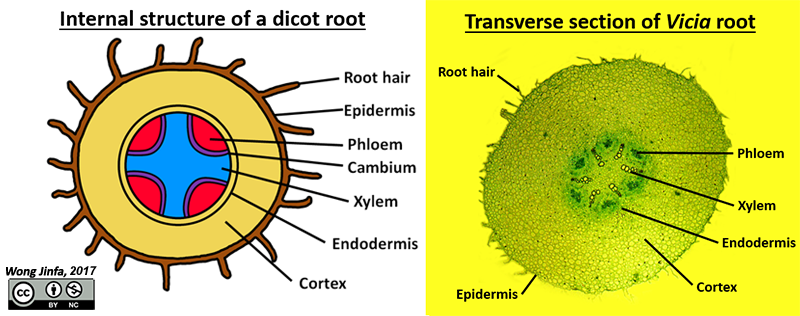
¶ Stem
- The outermost layer of cells in the stem is called the epidermis
- The epidermal cells are protected by a waxy, waterproof cuticle that greatly reduces evaporation of water from the stem
- The region between the vascular bundles and the epidermis is the cortex
- The cortex contains ground tissue that supports the other plant cells and stores starch granules
- The vascular bundles are made up of xylem, phloem and cambium cells
- The xylem tissue cells, positioned nearer to the center of the stem, are responsible for transporting water up the plant
- The phloem tissue cells, positioned nearer to the peripheral of the stem, are responsible for transporting dissolved nutrients up and down the plant
- Cambium cells, found between the xylem and phloem cells, actively divide and differentiate into new xylem and phloem cells, giving rise to the thickening of the stem
- The vascular bundles are arranged in a ring around a central region called the pith
- The pith contains ground tissue that supports the other plant cells and stores starch granules
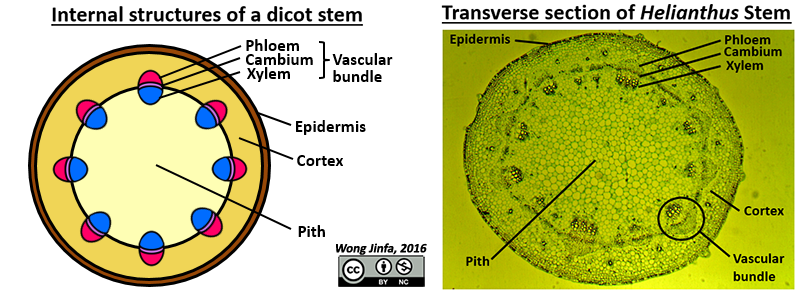
¶ Leaf
-
The first layer on the top side of the leaf is called the upper epidermis
- The upper epidermis is a single layer of closely packed cells
- A waxy layer of cuticle is found above the upper epidermis to prevent excessive water loss
- Cuticle does not block the stomata or sunlight from reaching the mesophyll layer
-
The layer below the upper epidermis is called the palisade mesophyll
- This layer of closely packed long, cylindrical cells contain numerous chloroplast for maximum absorption of light and is the main site for photosynthesis
-
The layer below the palisade mesophyll is called the spongy mesophyll
- This layer is made up of irregularly shaped cells, separated by numerous large intercellular air spaces, which allows rapid diffusion of gases inside and outside the leaf
-
The vascular bundles contain only xylem and phloem tissue and does not contain cambium cells (Found in spongy mesophyll layer)
- The xylem tissues, positioned nearer to the top, are responsible for transporting water up the plant
- The phloem tissues, positioned nearer to the bottom, are responsible for transporting dissolved nutrients down the plant
-
The first layer from the bottom side of the leaf is called the lower epidermis
- This single layer is made up of closely packed epidermal cells and guard cells
- The opening between two guard cells is called the stomata
- The lower epidermis contains much more stomata than the upper epidermis
- Stomata allows gaseous exchange and transpiration to occur much more rapidly when they are open in the presence of sunlight
-

¶ Identify the structures that make up the xylem (xylem vessels) and phloem (sieve tube elements and companion cells), stating how they are adapted to carry out their transport function.
¶ Xylem Tissue
- Xylem tissues are mainly made up of xylem vessels
- Xylem vessels are made up of long, hollow and dead tubular cells with no cross walls and protoplasm.
- This reduces resistance for transporting water and dissolved mineral salts from the roots to the stems and leaves
- Xylem vessels are strengthened by a layer of lignin to prevent collapse of the vessel and provide mechanical support for the plant
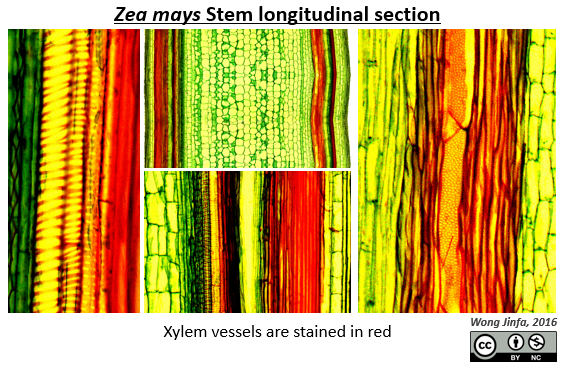
¶ Phloem Tissue
- Phloem tissues are made up of sieve tubes and companion cells
- Phloem conducts dissolved nutrients (sucrose and amino acids) from photosynthetic parts of a plant to other parts of the plant by translocation
- Sieve tubes are made up of living tubular sieve tube element cells which are connected through end walls with pores known as sieve plates
- The many tiny pores on the sieve plate allow rapid flow of dissolved nutrients (sucrose and amino acids)
- The sieve tube elements have lost most of its organelles and only has a thin layer of cytoplasm, therefore they rely on the companion cells to help with carrying out their metabolic process
- The companion cells contain numerous mitochondria
- Which provide energy carry out its metabolic processes
- And to provide nutrients to sieve tube elements
¶ Explain the forces involved in the transportation of water and ions (mineral salts) up the plant (transpiration pull, capillary action and root pressure).
¶ Entry of Water into the Plant
- The main process that results in the intake of water into the plant root hairs is osmosis
- The cytoplasm in the root hair cell is relatively more concentrated with sugars and salts compared to the water in the surrounding soil
- Water thus moves from a region of higher water potential in the soil into the region of lower water potential in cytoplasm of the root hair cell through the partially permeable cell membrane by osmosis
- The entry of water dilutes the root hair cell cytoplasm, which now has a higher water potential compared to the neighboring cells found further in the root
- Hence, water moves by osmosis from the root hair cell into these neighboring cells
- Thereafter, water continues to move by osmosis from these cells to the subsequent cells deeper in the cortex until it reaches the xylem
- Mineral salts are absorbed into the root cell by:
- Active transport (when the concentration of mineral salts is higher in the root cell sap compared to the surrounding soil solution)
- Diffusion (when the concentration of mineral salts is higher in the surrounding soil solution compared to the root cell sap)
- Water can diffuse across the cortex through three pathways
- Apoplast pathway: Water flows through the cell wall between two cells
- Symplast pathway: Water flows through the cytoplasm of two cells that are connected by a channel called the plasmodesmata
- Vacuolar/transmembrane pathway: Water flowing through the cell wall, cell membrane, tonoplast and vacuole of each cell
- Water mainly flows through the apoplast and symplast pathway
- A small amount of water may flow by the vacuolar/transmembrane pathway as there is high resistance to pass through the many structures
- Water may also alternate between the pathways (e.g. move from cell wall to cytoplasm and vice versa)
- At the endodermis, water is prevented from moving through the cell wall (apoplast pathway) by a layer of waxy suberin, called the Casparian strip, and has to pass through the cell membrane into the cytoplasm of an endodermal cell to enter the root's center
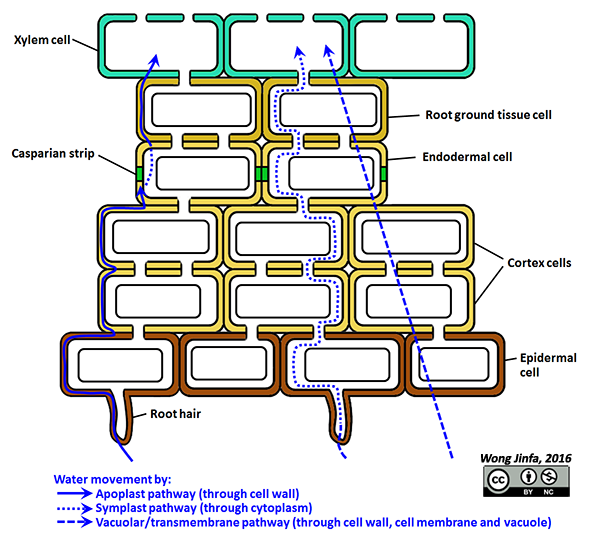
¶ Movement of Water Against Gravity
- Three processes help water move from the roots to the stem and leaves
- Root pressure
- Root pressure is the pressure resulting from the constant entry of water into the roots
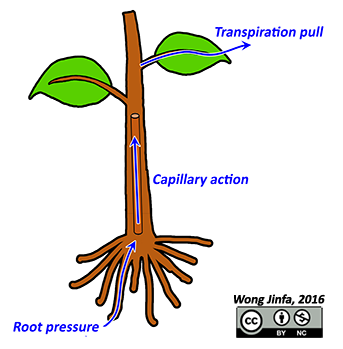
- Cells that surround the xylem vessels in the root actively pump mineral salts into the xylem vessels
- Water potential in the xylem vessel decreases, creating a water potential gradient
- This causes water to enter it by osmosis and the increasing pressure pushes the water column up the xylem
- Root pressure is only able to bring water up to a theoretical height of approximately 10 m and is unable to bring water all the way to the tops of tall trees (minor pushing force)
- Root pressure is the pressure resulting from the constant entry of water into the roots
- Capillary action
- Capillary action is the tendency of water to move up inside very narrow tubes
- It is due to:
- Cohesion: Attraction of water molecules to one another
- Adhesion: Attraction of water molecules to the walls of the narrow tube (xylem vessel)
- As the typical radius of xylem vessels is 20-25 µm, the maximum height of water that can be moved up by capillary action is approximately 75 cm (minor pulling force)
- Transpiration pull
- Transpiration pull is the suction force that pulls up the stream of water that moves up the plant (transpiration stream)
- It is able to bring water up to a theoretical height of approximately 120 m to 133 m and is the major pulling force responsible for bringing water up plants
¶ Define the term transpiration, describe how it takes place in terms of water potential and explain that transpiration is a consequence of gaseous exchange in plants.
¶ Transpiration Definition
- Transpiration is the loss of water as it evaporates from aerial parts of the plant, mainly through the stomata of the leaves
¶ Transpiration Process
- Water in xylem vessel moves from cell to cell via osmosis to form a a thin film of moisture over the surfaces of the mesophyll cells
- Water evaporates from the thin film of moisture to form water vapour, which accumulates in the intercellular air spaces, resulting in a higher concentration of water vapour inside the leaf compared to the air outside
- Water vapour thus diffuses through the stomata into the drier air outside the leaf
- Movement of water out of the mesophyll cells to replace the thin film of moisture that has evaporated decreases their cell saps' water potential
- The mesophyll cells hence absorb water via osmosis from the cells deeper in the leaf which has higher water potential
- These cells, in turn, absorb water from the xylem vessels which results in the suction force that pulls the column of water in the xylem vessels up
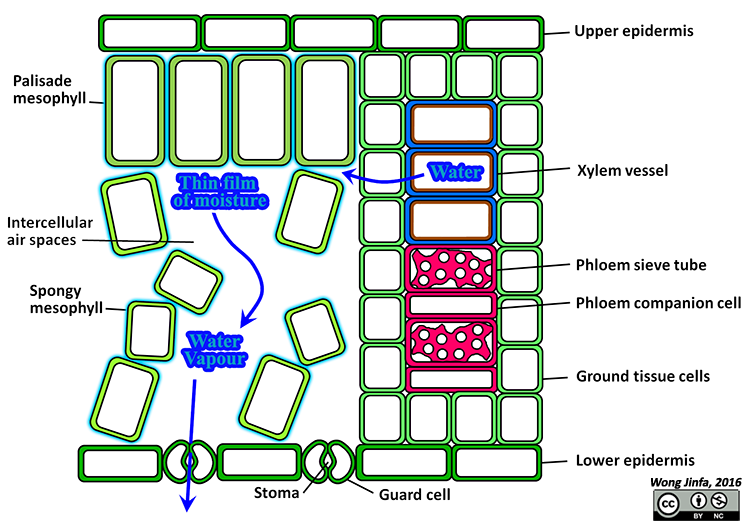
¶ Why is Transpiration a Consequence of Gaseous Exchange in Plants?
- The stomata needs to open for gaseous exchange but this allows water vapour to be lost to the atmosphere by diffusion which in turn allows for more water to evaporate from the surfaces of the spongy mesophyll cells
¶ Importance of Transpiration
- Cools the plant by removing latent heat of vaporisation
- Brings water to leaves for photosynthesis
- Delivers dissolved mineral salts along with the water in transpiration stream from roots to other parts of the plant
- Brings water to various plant parts to maintain cell turgidity
¶ Describe and explain the effects of variation of air movement, temperature, humidity and light intensity on transpiration rate.
¶ Humidity
- Rate of transpiration decreases as humidity increases
- Intercellular air spaces are usually saturated with water vapour
- When humidity is low (e.g. dry weather), there is a steeper water vapour concentration gradient between air spaces in leaf and surrounding air which results in a higher rate of transpiration
¶ Wind or Air Movement
- Rate of transpiration increases as wind speed increases
- Water vapour that diffuses out of stomata tends to accumulate around the leaf
- Wind blows away the accumulated water vapour, so that the water vapour concentration gradient between the intercellular air spaces in leaf and atmospheric air is larger
¶ Temperature
- Rate of transpiration increases as air temperature increases
- As temperature increases, water molecules gain kinetic energy and move faster
- Thus, rate of evaporation from mesophyll cells (# rate of transpiration) increases
- However, excessive water loss from guard cells may cause them to become flaccid and close the stomata, reducing any further increase in the rate of transpiration despite the increase in temperature
¶ Light Intensity
- Rate of transpiration increases as light intensity increases
- In the day, the stomata open, thus rate of transpiration increases
- At night, the stomata close, thus rate of transpiration decreases

¶ Describe and explain how wilting occurs, and state how plant are adapted to reduce transpiration rate.
¶ Wilting
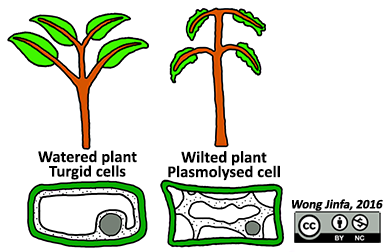
- Turgor pressure allows non-woody plant parts to maintain their shape and keep upright
- When plant cells lose water through osmosis, turgidity decreases, and cells become flaccid, causing the plant to wilt and look shriveled and curled up
- Wilting occurs when the rate of water loss through transpiration is more than the rate of water absorption by plant roots
- How does wilting help to prevent further water loss?
- When the plant wilts, guard cells are flaccid and the stomata close, hence rate of transpiration is reduced, reducing excessive water loss
- The surface area exposed to sunlight is also reduced which reduces water loss through transpiration
- However, this also decreases intake of carbon dioxide which decreases the rate of photosynthesis
- In addition, when leaves droop, they also decrease absorption of sunlight and decrease rate of photosynthesis
¶ Adaptations to Reduce Transpiration Rate
- Thick waxy cuticle, which is impermeable to water, helps reduce transpiration rate
- Rolled-up leaves, hairs at the epidermis and sunken stomata in pits traps water vapour close to the leaf, increasing humidity around stomata, thus reducing transpiration rate
- Leaves are reduced to spines with minimal surface area for transpiration reduces transpiration rate
- Reduced number of stomata reduces gaps for water vapour to escape which reduces transpiration rate
¶ Define the term translocation as the transport of sucrose and amino acids in the phloem tissue and illustrate the process through translocation studies (ringing, aphid stylet, radioactive carbon-14 tracing experiment).
¶ Translocation
- Translocation is the transport of manufacture food substances (e.g. sucrose & amino acids) in the plant
- Translocation is bi-directional, the direction where the manufactured food substances are transported to depends on the demand and supply for it
- When photosynthesis occurs, excess glucose that is produced at the photosynthetic parts is converted to sucrose and transported down from the to the other (lower) parts of the plants for use or storage
- When environmental conditions are not ideal, storage organs become the source of food for the plant and food is translocated up to the (higher) parts of the plant where food is lacking as no photosynthesis is able to take place
¶ Translocation Studies
- Ringing Experiment

- Procedure
- Cut off a complete ring of bark from the main stem of a woody twig
- Set up a control using an unringed twig
- Ensure that the bottom end of both twigs are in contact with water, with the ring above the water level
- Observe the twigs daily
- Results & Discussion
- The ringed twig has swelling in the stem just above the ring while the unringed twig has no visible change
- The ringed twig had its phloem removed, which prevents the translocation of sugars to the region below the ring
- The accumulation of sugars in the region just above the ring lowers the water potential of the cells in that region, resulting in water to enter by osmosis, causing the region to swell
- Conclusion
- Phloem transports food substances from leaves (upper part) to the rest of the plant (lower part)
- Aphid Stylet Experiment
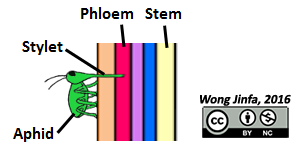
- Procedure
- Anaesthetize the aphid with carbon dioxide while it is feeding on a stemCut off its body such that its proboscis remains in the plant tissue
- Analyse the liquid that flows out from cut end of the proboscis
- Do a longitudinal section of the stem that contains the proboscis and examine it under a microscope
- Results & Discussion
- Stem section show that the aphid’s proboscis is inserted into the phloem of the plant
- Analysis of the phloem sap shows the presence of sucrose and amino acids
- Conclusion
- Phloem is the tissue that is involved in the translocation of the plant’s food substances since the liquid from this tube contains sucrose and amino acids
- Radioactive Carbon-14 Tracing Experiment
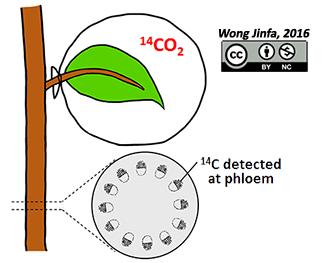
- Procedure
- Place an intact leaf in an enclosed transparent chamber with radioactive carbon-14 dioxide
- Allow photosynthesis to take place
- Cut a transverse section of the stem and expose it onto an X-ray photographic film
- Results & Discussion
- Carbon-14 is a radioactive isotope that will be taken up by the leaf during photosynthesis and incorporated into glucose and then sucrose
- Radioactive sucrose in the phloem causes X-ray film to darken
- Conclusion
- Phloem is the tissue that transports sugar in a plant
¶ Explain the principle and criticisms of the mass flow hypothesis, electro-osmosis hypothesis and cytoplasmic streaming hypothesis in accounting for the transport of sucrose in the phloem sieve tube.
¶ Mass Flow / Pressure Flow Hypothesis
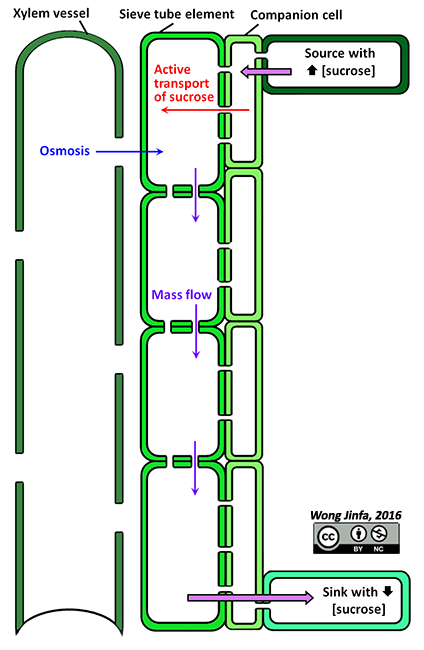
- Principle
- Flow of materials between source and sink is driven by turgor pressure gradient produced by
- Water entering phloem at source (site of sucrose production)
- Water leaving phloem at sink (site of sucrose utilization)
- Companion cells actively load sugar into sieve tubes at source:
- ATP supplies energy to pump protons out of sieve tube elements
- Proton gradient drives uptake of sucrose by co-transport of protons back into sieve tube elements
- Sucrose therefore accumulates in sieve tube element resulting in a lower water potential
- This causes movement of water into the sieve tubes by osmosis thereby generating a high hydrostatic pressure
- Companion cells unload sucrose from sieve tubes at sink:
- Actively (requiring ATP) against a concentration gradient
- Passively (not requiring ATP) when sucrose concentration is low due to respiration or conversion to starch for storage
- As a result, water leaves the sieve tubes by osmosis thereby developing a low hydrostatic pressure
- The difference in hydrostatic pressure between the source and sink causes water and solute molecules to move from the source (leaves) to the sink (roots)
- The movement of water and solute molecules in the same direction is known as mass flow
- If sucrose is constantly being produced at the source and being utilized at the sink, then the difference in hydrostatic pressure will be maintained for mass flow to occur
- Flow of materials between source and sink is driven by turgor pressure gradient produced by
- Evidence
- Observed in microscopic sections of living sieve tube elements
- Concentration gradient exists (high concentration of sugars in leaves and low concentration in roots)
- Translocation of chemicals and viruses on leaves only occur when leaves photosynthesises in the presence of light but not in the dark
- The pholem sap is under pressure as indicated by a flow of solution from the phloem tissue when it is pierced by an aphid stylet
- Criticisms
- Mass flow hypothesis does not explain for the existence of barriers, such as sieve plates or phloem protein, which are expected to be lost during the course of evolution
- Mass flow hypothesis does not necessitate phloem tissue to be living tissue
- Translocation stops when potassium cyanide enters phloem tissue, indicating ATP is needed. However, Mass flow is a passive physical phenomenon. It also does not explain for the big number of mitochondria in companion cells.
- The mass flow hypothesis suggest that all materials are transported at same speeds although proteins and sugars are transported at different rates in reality.
¶ Electro-osmosis Hypothesis
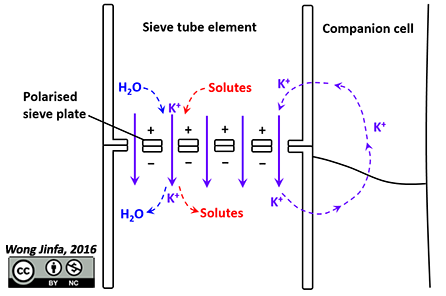
- Principle
- Companion cell produces ATP to generate potential difference across the polarised sieve plate for electro-osmosis to occur
- This occurs by active transport of potassium (K+) ions out from the sieve tube element at the lower side of the sieve plate into the companion cell and diffusion back into the sieve tube element at the upper side of the sieve plate
- This results in a higher concentration of K+ ions at the upper side compared to the lower side of the sieve plate resulting in electro-osmosis: The movement of potassium ions through the pores of the sieve plate rapidly draws water and dissolved solutes (sucrose) through
- Evidence
- The movement is still one of mass flow cut accounts for the existence of sieve plates
- High level of potassium ions are found in sieve tubes
- It accounts for the high metabolic rate of companion cells and the numerous mitochondria present in them
- Criticisms
- There is no consistent evidence of a potential difference existing across sieve plates
¶ Cytoplasmic Streaming
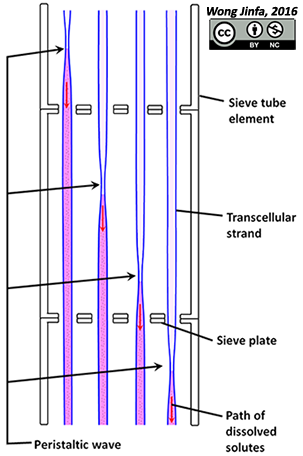
- Principle
- Cytoplasmic/Transcellular strands are fine protein filaments (tiny tubules, with a diameter of 20 nm) that are continuous through pores between sieve tube elements
- Solutes may be transported by cytoplasmic streaming along the surface of the protein filaments
- Bi-directional transport of solutes are achieved by some filaments conveying solutes downwards while others conveying solutes upwards
- Solutes may also be transported by cytoplasmic streaming through the protein filaments
- Cytoplasmic streaming occurs as a result of contractile proteins producing peristaltic wave-like movements
- This process is active and requires a large amount of ATP
- Evidence
- This process is active and accounts of the presence of numerous mitochondria in both the sieve tube elements and companion cells
- Criticisms
- Cytoplasmic streaming has been observed in immature sieve tube elements only
- Cytoplasmic streaming moments are not fast enough to account of the observed rates of transport in the phloem
¶ References
- Lam, P. K. & E. Y. K., Lee (2013). GCE 'O' Level Biology Matters- Textbook- 2nd Edition. Marshall Cavendish Education, 463 pp.
- Hoh, Y. K. (2012). Longman A Level Course in Biology (Core Syllabus, Volume 1). Longman Publishing Group, 503 pp.